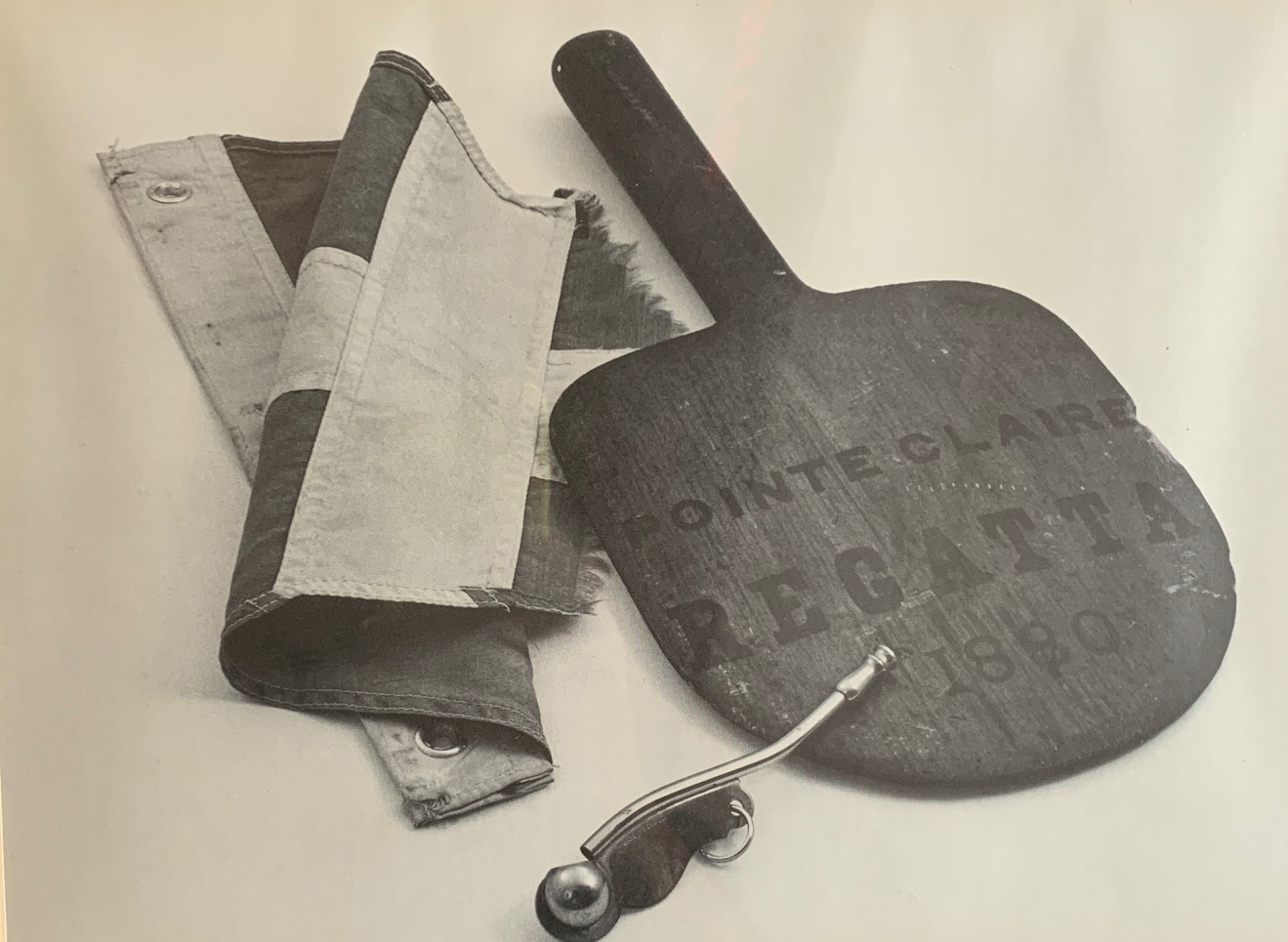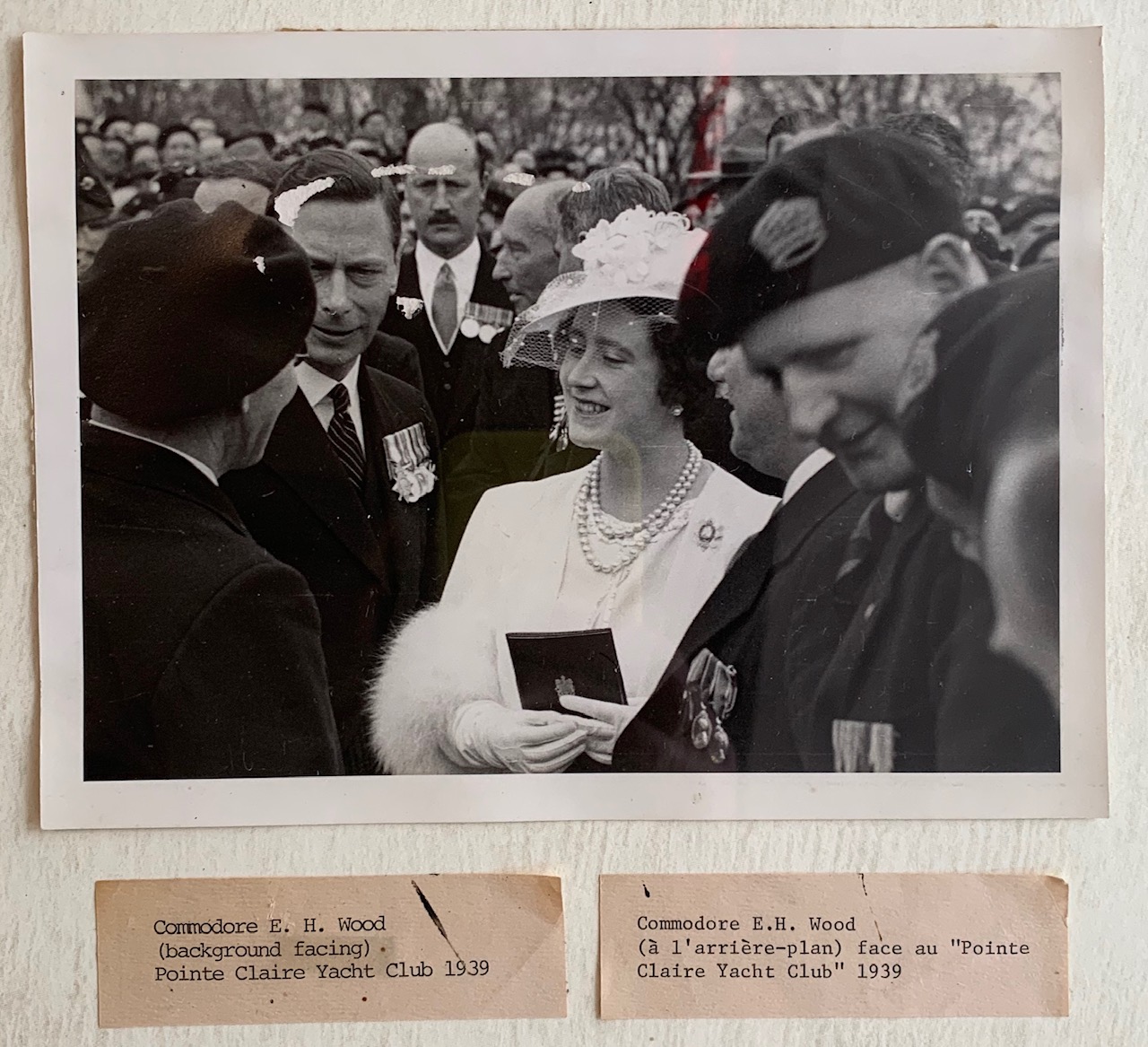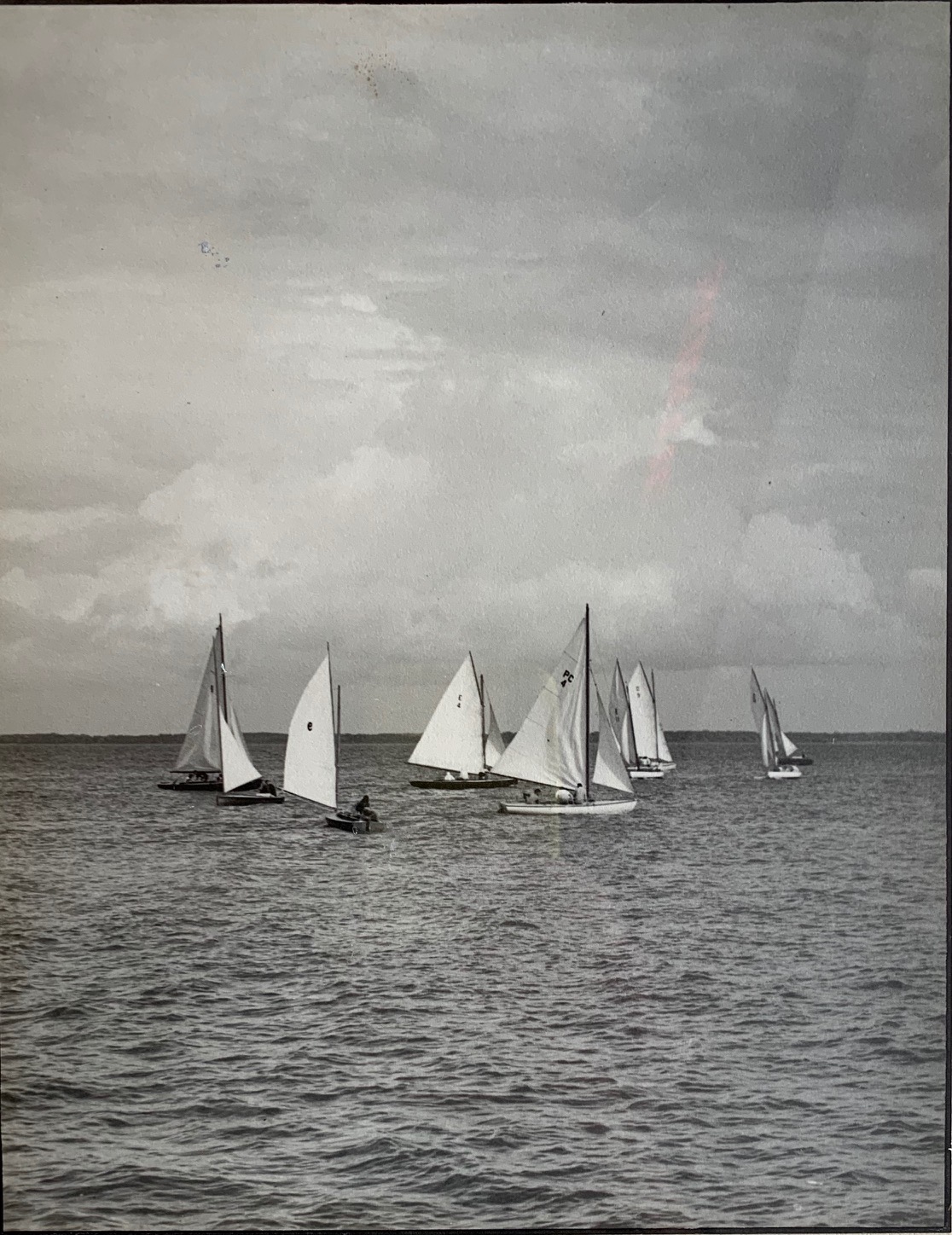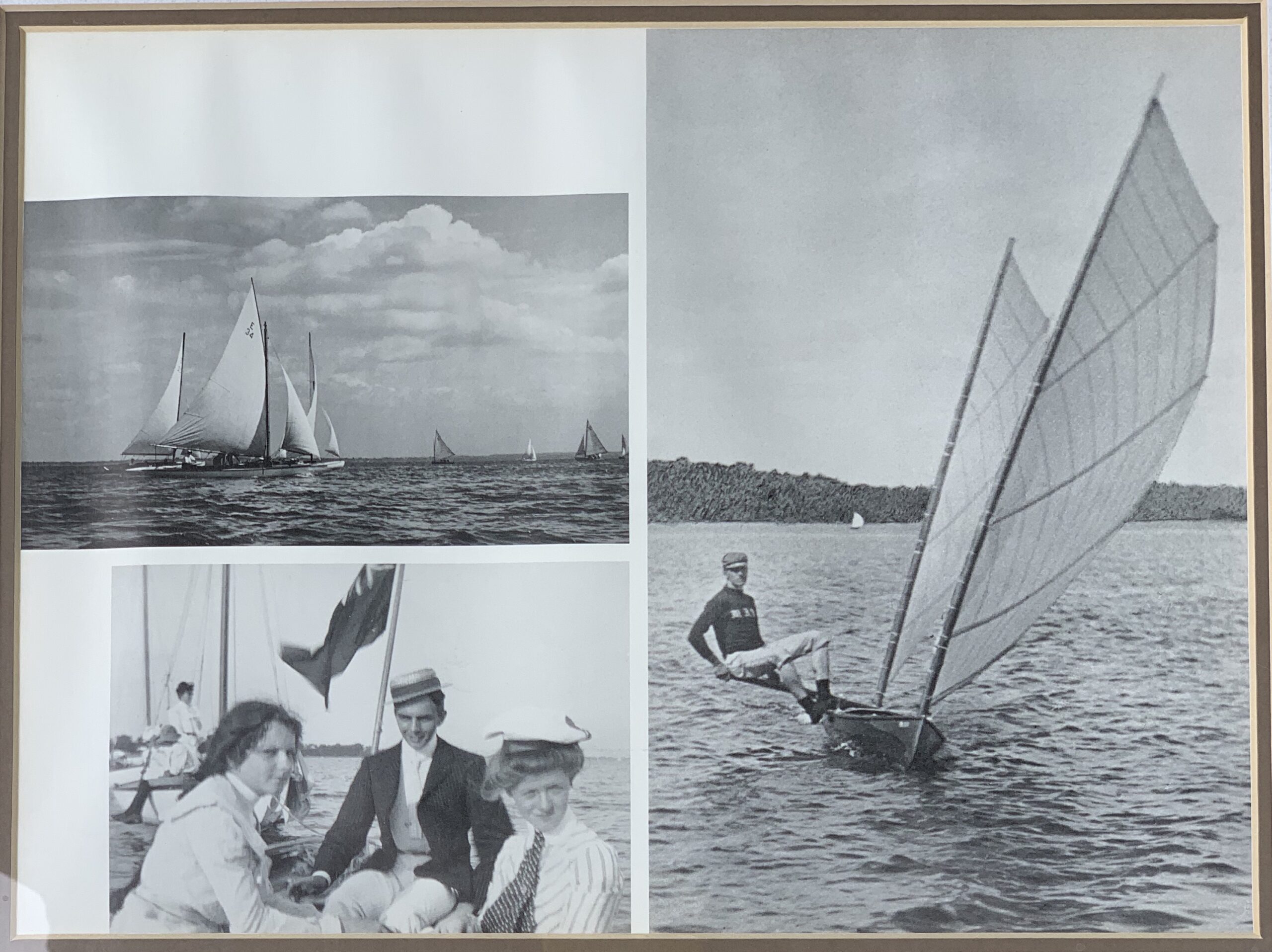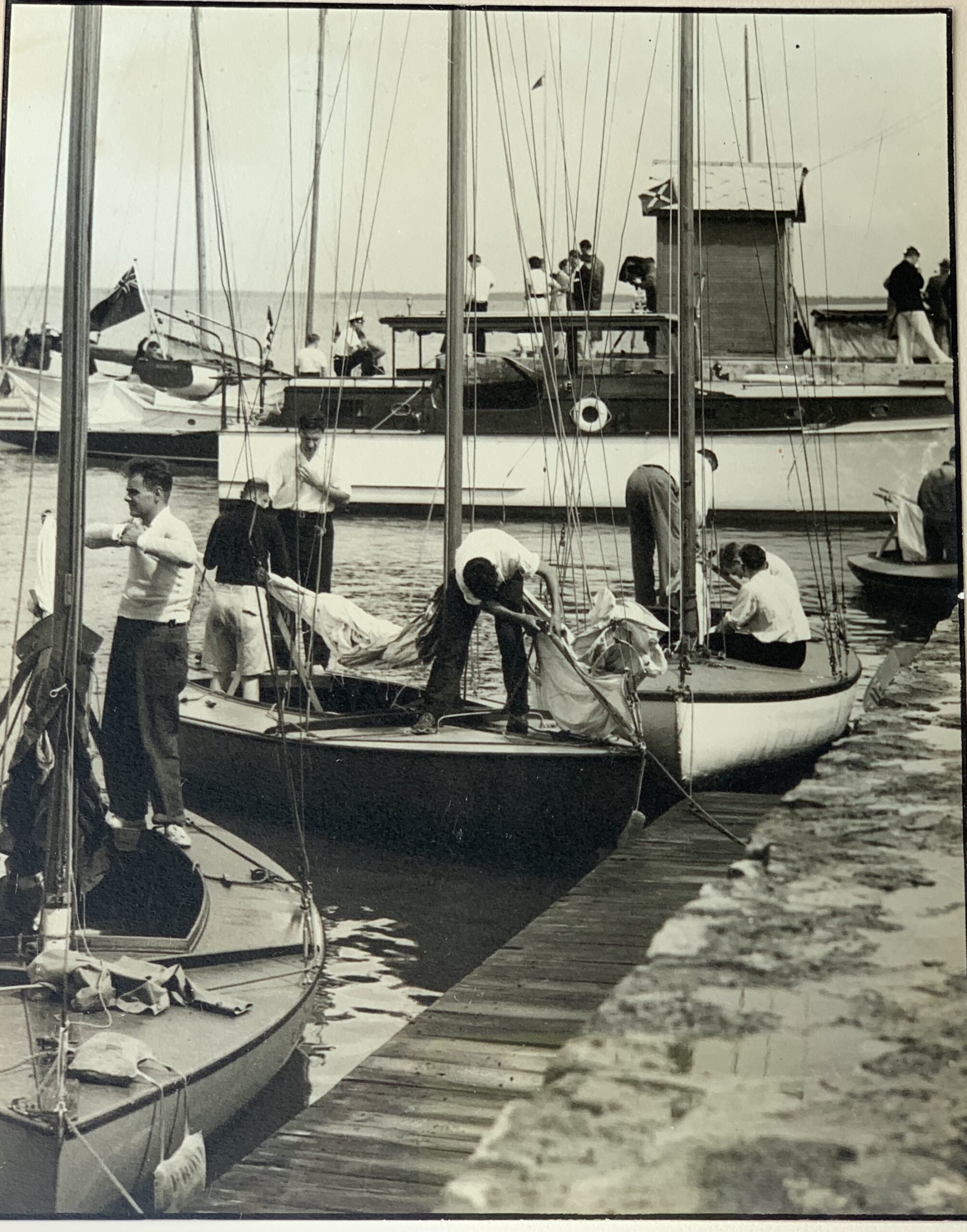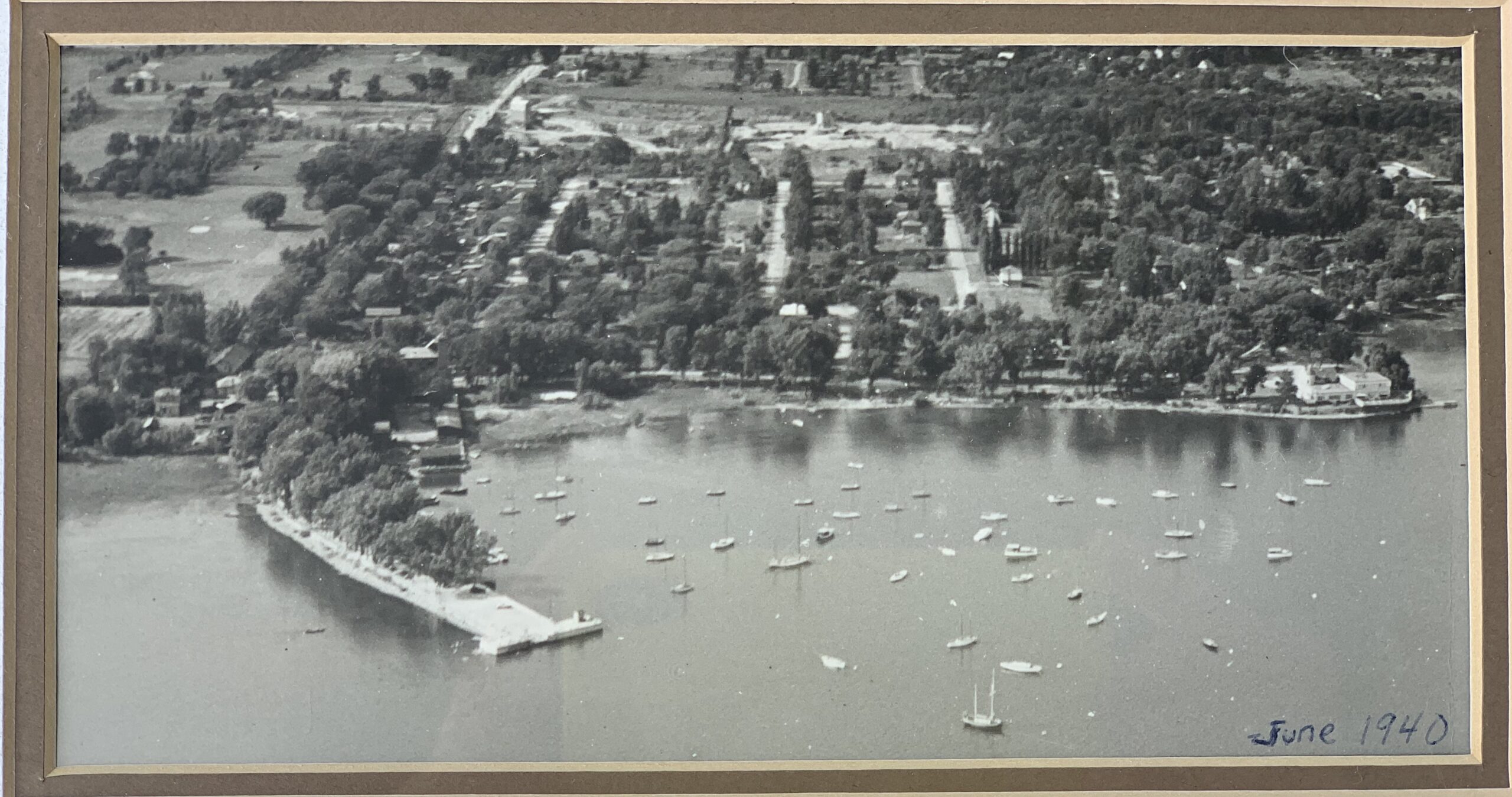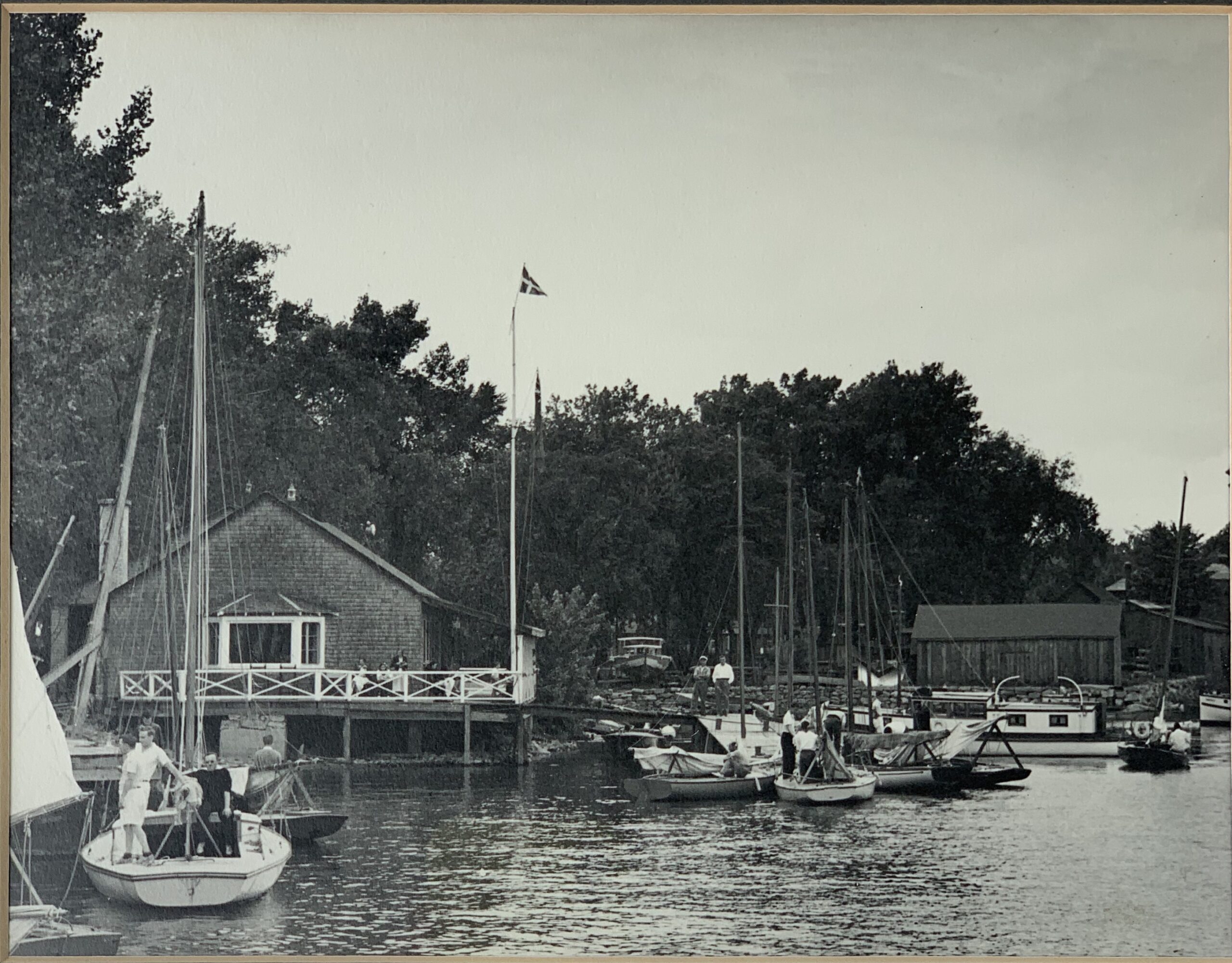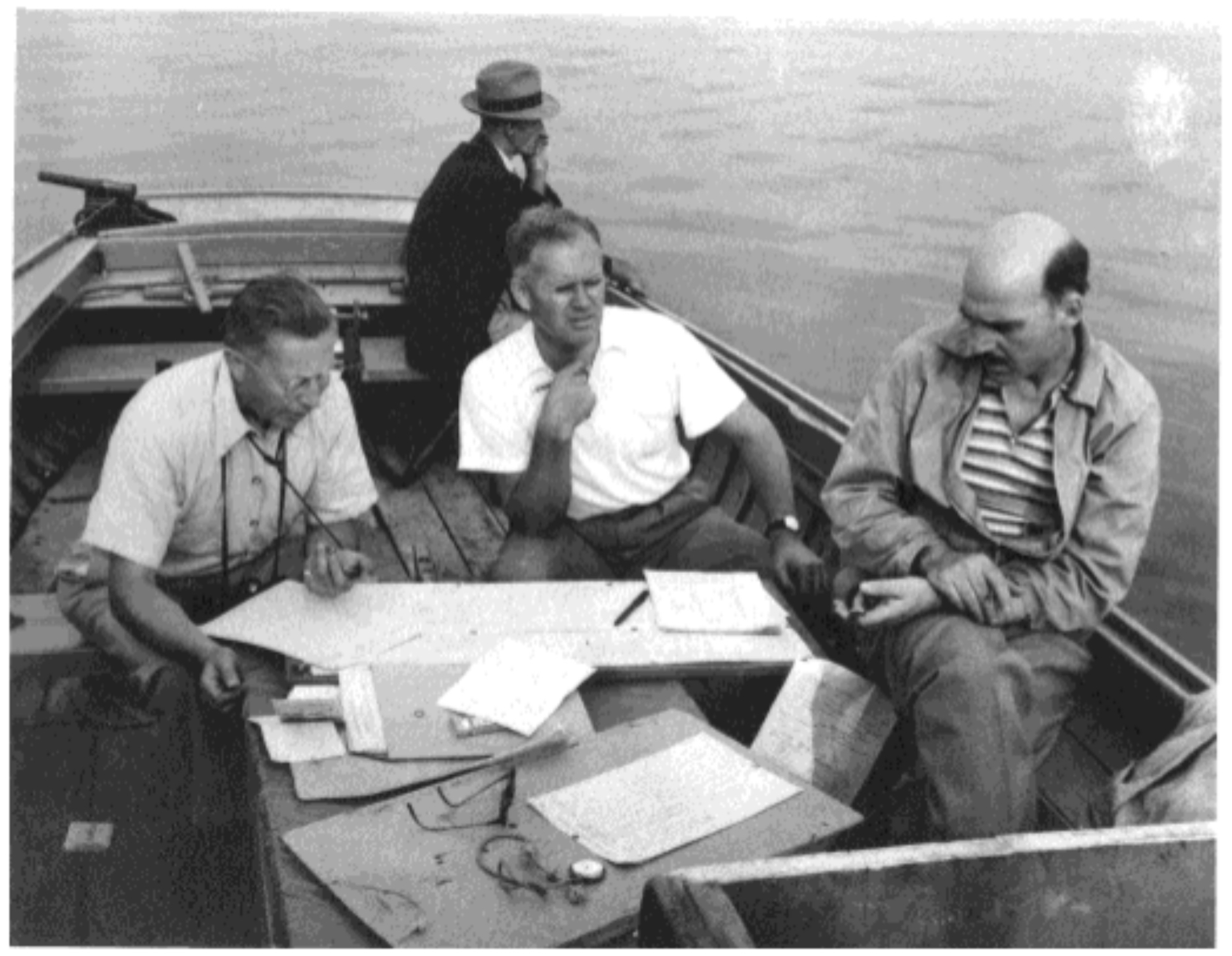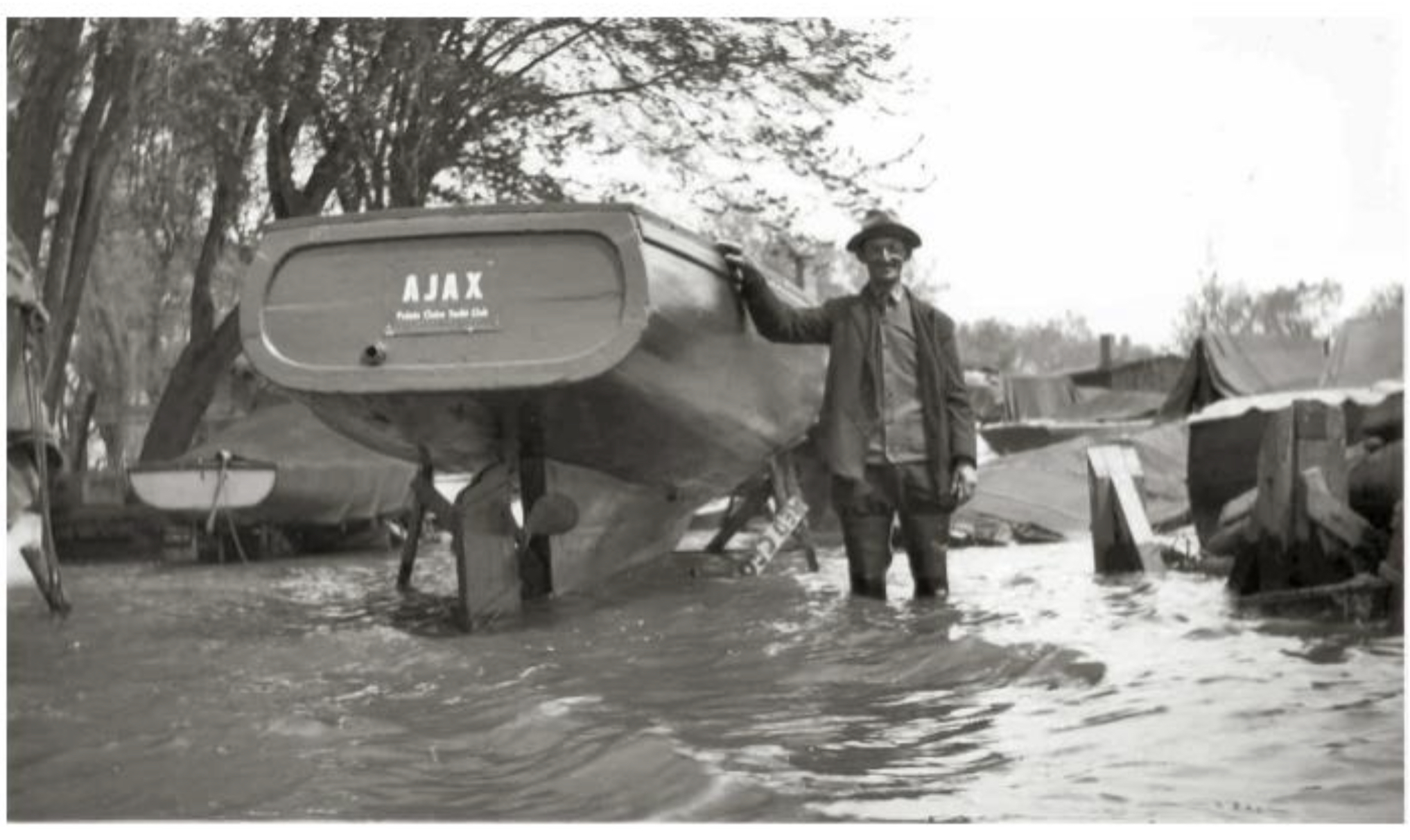The tradition continues
The club initially formed in 1879 as the Point Claire Boat Club, and while it primarily catered to paddling sports, all types of boaters were quick to establish their presence at this ideal location. In 1892 the Corinthian club formed, and with its dinghies brought a greater prominence to sailing and also regular racing. Over the years PCYC continued to develop its programs and school adding our first one design centerboard class in 1933 and in 1996 the AQVA (Association Québécoise de Voile Adaptée) adapted sailing program for people with disabilities. True to its roots PCYC has remained an inclusive club continuing to host a variety of fleets from dinghy sailing to cruising, racers to power boaters. All are welcome and the only requirement is a passion for boating.
Explore the ANCHOR WATCH, a PCYC newsletter tracing its origins to the early 1950s. Immerse yourself in the tales of past events and activities, sure to bring a smile or two.
PCYC Detailed History – 143 years of tradition
1. A Brief Review of Early Yachting at Pointe-Claire
It was in the year 1863 that the G.T.R. (Grand Trunk Railway) took possession of the pier built by the contracting firm of Pete, Brassey and Bette at Pointe-Claire, Quebec, some 15 miles west of Montreal. This pier, located at the foot of the road leading from the shores of Lake St. Louis to the G.T.R. Station, was built of limestone blocks taken from the ridge half a mile back from the lake and extends out into the lake about eight hundred feet. Its immediate purpose was to permit shipment of stone from the quarry on the ridge, the stone being used in the construction of the piers for the Victoria Bridge, which connects the Island of Montreal with the mainland to the south.
Sixteen years later, in 1879, a group of boating enthusiasts formed the Pointe-Claire Boating Club, which was fortunate enough to secure from the G.T.R. a lease to part of the pier on which to erect club buildings and carry on the Club’s activities. The location was an excellent one, in the broadest part of the lake, and easily accessible from Montreal, and past events have proved that the founders of the Pointe-Claire Boating Club made a very good choice of a site for their new club.
In its early years the Club’s principal interest lay in paddling, (though there were times when sailing was quite popular), and the blue and white colours of the P.C.B.C. were carried successfully in many a Canadian Canoe Association meet.
After World War I, however, it became apparent that the future development of the Club depended on the encouragement of sailing in its various branches, and in 1924 the Pointe-Claire Yacht Club was formed to take over the old Boating Club. With this re-organization new life was given the Club; its difficulties were successfully met and surmounted until, at the outbreak of World War II, the P.C.Y.C. was one of the most active sailing clubs in its district, boasting a fleet of 89 yachts of all types (of which 66 were sailing craft or auxiliaries), with the relatively small membership of 134 seniors and 173 of all classes.
Early in September 1939 several members of the Club left to joint Active Service Units, mostly in the Navy. Among these were Commodore F.B. Latchmore, Vice Commodore W.G. Rose, Hon. Secretary C.A.E. White, Chairman of the Sailing Committee Ian MacKay, and George Mathewson of the Executive Committee. To replace these officers, the Club was fortunate in securing the services of a number of past flag officers, namely, E.C. Janes, T.H. Bacon, A.S. Poe, A.F. Robertson and J.C. Kenkel respectively.
In 1940 the P.C.Y.C. faced a difficult situation, and the then officers and executive decided to carry on the usual activities of the Club, reducing the programs where necessary and economizing wherever possible. During 1941 and 1942 the membership declined as more and more members entered the Services, but in 1943 and 1944 there were several new members and sailing activity took an upward turn. By the end of the 1943 season the Club was free of bonded debt, and at the end of 1944 the P.C.Y.C. was in an excellent position to meet whatever eventualities might arise. By then total membership had risen to 153, of which 130 were seniors, while the Honour Roll included the names of 56 members serving (or who had served) with the Navy, Army and Air Forces. The squadron list showed a total of 73 boats of all types and sizes, the sailing fleet number 61. With every active membership, a substantial bank balance and the Club properties well maintained despite the stress and strain of the war years, the P.C.Y.C. could look forward with confidence to the future, and backward on twenty years of solid progress of which the members had every right to feel proud.
Since its inception the Pointe-Claire Boating Club and its successor, the P.C.Y.C., have always stressed the truly amateur aspect of aquatic sports, the members have always done a great deal of voluntary work for their club while the Yacht Club has consistently done its best to encourage owners to work on their boats; to provide them with storage and harbour facilities at moderate cost; to develop that pride in owning a boat and keeping it in first-class shape which is so essential to the full enjoyment of the sport; to interest its members in designing as well as in sailing their boats. As a result the Pointe-Claire Yacht Club numbers among its membership a large proportion of enthusiastic boat owners, many of whom have either designed their own craft or else rebuilt them to their own ideas.
Lake St. Louis is not blessed with the deep water and wide spaces of such fine sailing grounds as Lake Ontario and the majority of the boats developed on the lake in the 30’s and 40’s were shoal draft centre-boarders. Quite a number of heavy displacement, keel sloops, yawls and schooners have jointed the P.C.Y.C. fleet over the years. These boats are quite heavily built, seaworthy craft with a maximum draft not much over 4 feet and the remarkable fact is that the Cruising Class, made up of these yachts, has provided quite good racing using a past performance handicap. Other classes include the D-Class composed of centreboard sloops and yawls from 32 to 35 feet long with reasonable cabin accommodation for their crews of four, the E. Class yachts are 27-foot sloops, most being fitted with bilge-boards and a few of the older ones with centreboards. Probably the best racing class the P.C.Y.C. has yet had is the PC one-design class, a 19-foot Marconi-rigged sloop that was designed by C.D. Mower and built by Morris Boat Works.
During the 1933 season an important development took place beginning with the formation of a class of small sloops in which four boats raced regularly. Two of these were 21-foot boats of a class known as Hoboes that had been very popular in the early 1900’s. Both these boats were rebuilt and re-rigged; TAEPING, owned and sailed by E.J. Winters with a high Marconi sail plan and PETREL – V.A.. Linnell – with a Gunter-rigged gaff sail. The other two were Mower designed 19-footers. One of these, RENE (owned by H.G. Young and H. Godber), built in 1926, convinced those who studied her that the design was well suited for Pointe-Claire requirements. In the summer of 1933 a second 19-footer, GRAYLING, was ordered by Mr. Gray Miller. GRAYLING was a duplicate of RENE, except that her construction was strengthened somewhat, rigging and equipment revised and the new boat’s appearance and her performance in her first season’s racing created a lot of interest. During the summer a committee composed of T.H. Bacon, V.A. Linnell and A.S. Poe, Chairman, drew up rules, specifications and plans for the proposed new class. In the fall of 1933 the PC Class was officially formed and three new boats were ordered from Morris Boat Works in Hamilton with English sails made by Cranfield and Carter. The class was strictly one design. The rules were agreed to by all owners and it was decided that changes were only to be made with the unanimous consent of all owners.
Time has proven the wisdom of the 1932 Sailing Committee since the PC Class rules changed very little over the years. The class increased to 17 boats by the end of the 50’s and has provided the keenest of racing.
In 1934 PC’s were manned by a crew of three and were constructed with a reround bilge and square transom, outboard rudder with a centerboard. The midsection showed a little dead rise with a hard bilge giving plenty of stability. The bow sections were fined off more than the E’s and the boats handle very nicely. With a 6’-6’’ beam and large open cockpits, they are comfortable day sailors, as well they have done limited cruising, using a canvas cover over the boom. Their racing record has shown the wisdom of sticking to the out and out one-design idea. In 1946 the class was made up of ten boats, and any one could win with good handling and proper tuning. The PC’s carried a moderate Marconi rig, the main sail being 165 square feet in area with a 24-foot hoist and 12-foot, and the jib 39 square feet giving 204 square feet total area. A syndicate was formed in 1945-46 to finance PC’s in order to help increase the fleet. This syndicate, headed by Mr. Walter M. Stewart, would sell a PC on a time-payment basis to any member proposed by the sailing committee.
(Historical note) The Pointe-Claire Yacht Club, its officers and members, owe a deep debt of gratitude to Mr. and Mrs. Walter M. Stewart, whose continued interest and generosity (financial and otherwise) have made possible many of the improvements that have contributed so greatly to the convenience and comfort of members since 1925. It is believed that Mr. Stewart was out sailing on one occasion approx. date 1925 1926, his life was saved when members of the Pointe-Claire Boating Club rescued them.
As already stated the Pointe-Claire Yacht Club is not large and its clubhouse and facilities are far from elaborate, but serve to meet reasonably well the demands put upon them while still preserving the fundamental principles upon which the Club has prospered – that of giving members reasonable Club facilities as well as harbour space for their boats in summer and storage room in winter, all at a very moderate cost.
2. The Pointe-Claire Boating Club Formed
The history of the P.C.Y.C., and its predecessor, is an interesting one and will be outlined briefly.
Original founding members
When the Pointe-Claire Boating Club came into existence, in 1879, its membership totaled only 37; at a minimum of expense a clubhouse was erected, a frame building on wood posts, and the members themselves designed and put up the clubhouse. That they made a good job is evident from the fact that the original structure still stands and now comprises the lounge room, kitchen and main hall of the present club.
P.C.Y.C. is one of the oldest yacht clubs in North America 1879. On going research suggests that we have “the” oldest clubhouse in its original form on its original site and still used for its original purpose. Quite a feat considering that ours is of wooden structure and the other 64 other clubs that are older than us have scrummed to fires, floods, hurricanes and voluntary demolition.
The first president and man who was principally responsible for the formation of the P.C.B.C. was Capt. H. Harriman, and among the Club’s charter members were:
- A.M. Bell
- F. Gallagher
- G.G. Garner
- Geo. Green
- J.T.P. Green
- Samuel Green
- A.C. Hamilton
- H. Haphall
- A. Heney
- Major Stuart Howard
- Fred. H. Hueback
- J.G. Hunt
- Geo. H. King
- J.E. Kirkpatrick
- G. McKinnon
- J.H. Menzies
- J.W. Nelles
- J.H. Paul
- H.M. Perrault
- Robt. Pinkerton
- E. Popham
- T.G. Roddick
- Alexander Spence
- J. Wilson
The Club’s activities in its first year were limited, more or less, to getting the club started and its clubhouse erected. At the end of the year a balance of twenty-six cents was carried forward, and in 1880 the P.C.B.C. was in full swing. In that year paddling and sailing regattas were held, a number of social activities took place and several boats were stored on the club’s property. In fact one of the prize trophy’s a wooden paddle is still in our possession There is not a great deal of authentic information available as to activities during this period, but in 1881 an addition to the building was made while by 1882 the sailing regatta attracted eight yachts and a number of smaller boats, principally skiffs and canoes. The membership increased steadily, and revenues mounted from $170 in 1879 to $860 in 1885. In 1888 there must have been considerable interest in rowing since the Club purchased a single scull shell in that year.
On April 7,1888 the St. Lawrence Yacht Club was formed to give Lake St. Louis its first real sailing organization, that Club received its Royal charter in 1894 and the R.St.L.Y.C. has been well known for its fine sailors since. During their first season they accepted the hospitality of the Valois Bay Boat Club, and held competitions from there. The second year 1889 the Pointe-Claire Boating Club granted their facilities and club house to their members.
3. The Corinthian Sailing Club
Then in 1892 an important development took place that brought sailing into prominence at Pointe-Claire. The St. Lawrence Yacht Club catered principally to the larger yachts and most of those craft on the lake belonged to that club. However, there was at that time, a very keen group of small boat sailors attached to the P.C. B.C., who formed the Corinthian Sailing Club and were instrumental in influencing the P.C.B.C. to build suitable quarters for the newly formed Sailing Club.
The original officers of the Corinthian Sailing Club were as follows:
| Hon. Commodore Robt. Meredith | Rear Commodore C.E. Archibald |
| Commodore W.J. White | Hon. Secretary E.L. Chadwick |
| Vice Commodore J.E. Ewing | Treasurer D.C.E. Miller |
While there were a few bigger boats enrolled in the new club’s fleet, the bulk were decked sailing boats known as “Sauvé” boats, being built by a Mr. Sauvé at Brockville, and sailing canoes, both decked and open.
The Sauve boats were long narrow double-enders rigged as luggers with bat s-wing sail they over canvassed would not stay right side up without a member of crew on board and naturally very fast but hard to sail.
The larger boats carried a crew of four, the smaller were manned by two, and hiking ropes and toe straps were regular equipment for every man of the crew. There were several decked sailing canoes with centerboards, sliding seats and bat’s-wing sails, among these being Charles.E. Archibald’s QUEEN MAB, for several years – champion of North America. Out of 200 start’s he came in first 195 times.
The open canoes also had their adherents and one of the prominent boats of this type was W.E. Bolton’s SEILA which was designed by Mr. Archibald, and was fitted with sliding seat and leeboards and carried 140 sq. ft. of sail, the same area as the 14-foot dinghies of today.
By 1894 the Corinthian Sailing Club was a very active organization. Its membership totaled 72, while the squadron list numbered 47 boats, made up of 7 sloops, 3 luggers, 1 cutter, 2 yawls, 7 catboats, 2 steam yachts, 17 skiffs and 8 canoes. The biggest boat in the sailing fleet was L.J. Smith’s VIKING, a 41 foot cutter designed by G.H. Duggan.
From 1889 to 1896 the Royal St. Lawrence was successful in developing a very fine class of eighteen-foot corrected-length sloops, also designed by G.H. Duggan, In 1889 Mr. Duggan led the way by maintaining that, by rounding the forward lines which automatically cut off the forefoot, he could save several feet in measured water line. In 1890 he designed an 18-foot boat which, while equal in corrected length to the older boats, was a much longer vessel with fifty percent more deck. This meant more power to carry sail and, what was a more important change, he planned a hull which slid over the water instead of cutting through it.. After this concept design was establish at the races, it was criticized by the public and christened “The Bug”, afterward admired and honored with the name “La Gloria” in which the famous series for the Seawanhaka Cup was sailed on Oyster Bay, long Island Sound in 1886, which resulted in that famous trophy coming to Canada where it remained for almost ten years.
These eighteen footers sealed the doom of the Sauvé boats and sailing canoes; they were fast and fairly dry, did not require acrobatic feats to keep them right side up and provided such wonderful racing that the Corinthian Sailing Club gradually died a natural death and its quarters became a storage shed for dinghies, canoes, etc. It is interesting to note that the “Canoe Shed”, as the old C.S.C. building became known, was only taken down in 1933 to make room for a new and much larger building for storage and general purposes. The Corinthian Sailing Club’s life was a short one, but it gave the Pointe Claire Boating club its first real taste of what was to become its most important activity – the sailing and racing of small boats.
In 1895 the Pointe Claire Boating Club’s Annual regatta must have been well worth seeing. Races for sloops, catboats, sailing skiffs, decked canoes and open canoes were held, the total number of entries being 29; while there were 7 paddling and 4 rowing events.
The period from 1896 to 1905 saw a great development in sailing on Lake St. Louis, this being the period when the Seawanhaka Cup was held by the Royal St. Lawrence Yacht Club, and interest in the sport reached a high stage. Following the loss of the cup in 1905, sailing was in the doldrums for a time, and no definite information is available on the activities of the P.C.B.C. until the years immediately preceding the war (WWI) which saw sailing slowly become a major part of the club’s activities.
In 1911 the Club’s schedule showed open and club paddling regattas, also three club sailing races and open sailing regattas.
The following year much the same program was followed out. A sailing committee composed of J. M. Morris, W.I. Ives and G.R. Taylor looked after the sailing and racing activities, which were steadily taking a more important place in the Club’s program.
4. Sailing Revives at Pointe-Claire
1913 was a big year for the Pointe-Claire Boating Club. After many unsuccessful applications, the Eastern Division Regatta of the Canadian Canoe Association was awarded to Pointe-Claire, which made the Club’s paddling activities very prominent. Also, interest in sailing was at quite a high level; several of the old four rater class (32 foot cabin sloops) were then owned by Pointe-Claire members and in this year two cups were presented for annual competition: the Mitchell’s Cup for Dinghies and the Pointe-Claire Challenge Cup for miscellaneous class yachts. The former trophy is now out of competition but the Challenge Cup has been raced for steadily since its donation (except for the war years) and is now one of the most coveted trophy in the possession of the P.C.Y.C., being raced for annually by the Fleet.
It is interesting to note that the first winner of the Challenge Cup, in 1913, was WA WA, a D Class sloop of the four-rater type, owned by Frank Mills and Walter Ives. After a long and successful career at Pointe-Claire WA WA was sold to a member of the Britannia Boating Club of Ottawa where she was still going strong in 1943, winning the club championship that year.
In 1914, the winners of the Challenge Cup were G.R. Grieve’s HABITANT and A.S. Poe’s GUDRUN. George Grieve gave his life in his Country’s service in World War I, and HABITANT’s name does not appear again on the list of P.C.B.C. trophy winners. For GUDRUN, however, this was but the beginning of what became one of the longest and most successful racing careers of any yacht that has yet flown the blue and white colours of the P.C.B.C. and P.C.Y.C. GUDRUN, a fast and able D Class sloop, owned and sailed by Alex S. Poe, John A. Currie, Ed C. James and J.D. Ralph at different times during her career; was flagship of the P.C.Y.C. when owned by Ed Janes and was sold out of the Club in 1943.
In the Fall of 1913, a general meeting was held to discuss possible reorganization of the Club with particular regard to a scheme for erecting a new clubhouse. However, when tenders for the proposed building were received, they were too high to be feasible, and the matter was held over for further consideration. The question of putting in a marine railway was discussed, this being necessary to handle properly the increasing number of boats seeking winter storage at Pointe-Claire.
1914 saw more sailing activity at Pointe-Claire than ever before. With an enthusiastic sailor, W.S. Clouston, as its President, new trophies to sail for and plans being made for the new clubhouse, interest in and around the P.C.B.C. was at a high level. Several races for the Challenge Cup were sailed, while a keenly contested series of three races for the cup presented by the President was a highlight of the season’s schedule, this being won by Dr. G.H. Parke’s GERALDINE.
During this summer the new marine railway was built, entering the clubhouse at its south end, the only spot where deep enough water for the purpose was available. Plans for the new clubhouse, and for financing its construction were gone into very thoroughly and it was decided to apply for a new charter for the club. Then came the war and on August 28th it was decided to drop the scheme for the new building and to return money already subscribed for this purpose.
Early in 1915 the Pointe-Claire Boating Club severed its connection with the C.C.A.(Canadian Canoe Association) and with its resignation from that body the club dropped permanently from the paddling world, as subsequent events proved. A shortened program of sailing was carried out, also two paddling regattas, but the departure for the front of many of its active members quite naturally cut down the schedule considerably.
By 1916 it was deemed necessary to hold no club sailing races, due to scarcity of racing boats and crews, and the club’s principal activities were social events held for the purpose of raising funds for patriotic purposes. Of interest is a note in the minutes of an executive committee meeting held on May 19th, 1916, to the effect that: “Owing to high water in Lake St. Louis the clubhouse could only be reached by boats and the Hon. Treasurer, (Mr. Arthur Harries), invited the committee to meet at his house.”
5. Property Purchased from G.T.R.
1917 and 1918 were hard years, particularly the latter, and when the 1919 season opened, it was evident prompt steps were necessary if the club were to regain its old position on the Lake. With the return from overseas of many of its members, and the growth in the number of boats in commission, the club was enabled to make a good start towards its revival. The question of a new clubhouse again came up for consideration, and in the meantime badly needed repairs to the existing buildings were carried out. Sailing and paddling regattas were held with a fair number participating in each, and negotiations entered into with the G.T.R. regarding a long-term lease of the property, or possibly its purchase.
On July 5th, 1920, it was reported to the Executive Committee, that the G.T.R. had accepted the Club’s offer for the whole of the property south of the Lakeshore road. Several members of the Club advanced the money necessary to complete the purchase, plans for a new clubhouse were begun, and application made to the Quebec Government for a charter for the new P.C.Y.C., with an authorized capital of $10,000 made up of $100 per value shares, the five members whose names appear as applicants for the charter being, Robert Meredith, O, Shenton, Major C.W. Meakins, F.W. Mills, S.H. Ward, Sr.
In November 1920, the transfer of the property from the G.T.R. to the Pointe-Claire Boating Club was completed, and work on the proposed reorganization was continued. Doubt to the Club’s title held up the work to some extent and there was a difference of opinion between the Town of Pointe-Claire and the Club on this point.
Interest in sailing was steadily building up, and in 1921 the Club’s annual regatta saw a big fleet of yachts, of the B, Four Rater and Miscellaneous classes and Dinghies in action.
In the fall of that year it was decided to close off the wharf to the public, the Club’s lawyers having given a favourable decision on the doubtful title referred to above. The wharf for many years, had been used by the citizens of Pointe-Claire for bathing and also for bringing in sand in barges, and the Town Council contested the Club’s right to close off the property. An application to the Province in 1922 for deep water rights was refused and the dispute with the Town reached considerable proportions.
1923 saw the Club’s sailing activities decidedly on the upgrade, three regattas were held and the Dinghy class was particularly active, the fleet of 14-foot Aykroyd-built dinghies being very strong on Lake St. Louis at this time. By the fall of 1923 the situation with regard to the property was becoming acute, the Club had suffered a loss in its season’s operations and nothing in the way of re-organization could be done until deep water rights were obtained and a settlement arrived at with the Town.
6. Pointe Claire Yacht Club Takes Over the Old Boating Club in 1924
On March 14th, 1924, the Club authorized an offer to the Town of Pointe-Claire to sell lot 90 (wharf) and part of lot 103 that part of the Club’s property not needed by the Club for a sum equivalent to the Club’s expenditure to date ($800). The conditions were to have the town erect a fence around the property, to permit the club to lay a surface water pipe to connect to the town’s nearest hydrant, to agree unconditionally to the club’s application for deep water rights, to a maintain as a public roadway the land they would acquire, to protect the trees, to provide lighting and to pay all notarial fees. 1924 was a momentous year in the Club’s history since it saw an agreement arrived at with the Town by which the Club sold a considerable part of its property to the Town and through this sale a new scheme for the Club’s development had to be drawn up; since there was not space for the new clubhouse as planned.
A special, general meeting held on June 9th, 1924, authorized the sale of the property as outlined above, and also decided to allow the charter of June 14th, 1921, to lapse, and to apply for a new charter under the name of the Pointe-Claire Yacht Club. It was also decided to refund those members whose generosity had made possible the purchase of the property in the first place; namely, W.M. Whitaker, H.E. Vautelet, F.W. Mills, A.F. Robertson(nick name Skipper), G. Shenton, S.H. Ward, Jr., and the estate of the Late Major C.W. Meakins.
The Pointe-Claire Yacht Club was incorporated under a Club charter only, without authorized capital, so as to avoid the possibility of a clique obtaining control of the common stock and so taking over the direction of the Club from the members. The whole question of the re-organization of the Club, including the new charter, was very carefully studied and the work put into this phase of the Club’s development was certainly productive of excellent results.
At 10:00 p.m. on July 11th, 1924, the old Pointe-Claire Boating Club ceased to exist, and the present Pointe-Claire Yacht Club came into being.
The “incorporators” were:
- Arthur Frederick Robertson, Chemist, Owner of “Thione”, a yawl – biggest yacht at the PCYC
- John Alexander Mitchell Engineer
- Thomas Hamilton Bacon, Engineer, Owner of “Annette” – 3-rater
- Francis Walter, MillsBroker, Owner of “Wa Wa” – 4-rater, “B” class
- John Cowan, Accountant, Owner of “Singa” – dinghy class
- Henry Renwick Crombie, Insurance Inspector, Owner of “Bluenose” – motorboat
- Harold Meredith James, Insurance Clerk
- Howard Wilding, Clerk, Owner of sailing skift
- Thomas Creighton Darling, Student, Owner of “Aloha” – dinghy class
- Alexander Spence Poe, Engineer, Owner of “Gudrun” (1924) – rater class
The original officers were:
- Commodore – A.F. Robertson
- Vice Commodore – J.A. Mitchell
- Rear Commodore – T.H. Bacon
- Hon. Secretary – J. Cowan
- Hon. Treasurer – F.W. Mills
- Harbour Master – H.R. Crombie
- Executive Committee – T.C. Darling, H.M. James, H. Wilding, A.S. Poe
- Sailing Committee – J. Cowan, Chairman, A.S. Poe, A.P. Shearwood
The balance of the 1924 season was used in formulating a development policy, in making badly needed minor repairs, in looking after the innumerable details necessitated by the transfer to the Town of Pointe-Claire of a considerable portion of the property previously acquired by the Club from the Grand Trunk Railway.
Mention should be made at this time of the help given by Mr. J.L. Vital Mallette, a good friend of the P.C.Y.C. Mr. Mallette, then a member of the Town Council and later Mayor of Pointe-Claire and Member of Parliament, was very helpful in negotiations with the Town and in the arrangements leading to the final agreement between Town and Club.
On October 31st, 1924, the deed of sale was passed, and a longstanding source of friction was amicably settled; a very necessary prelude to the development that has followed since.
The 1924 sailing season was an active one. In the Inter-Club Dinghy races the P.C.Y.C. crews were again successful. This year three races were sailed at Hudson and three at Pointe-Claire with crews from the Royal St. Lawrence Y.C., the Hudson Y.C., and the Pointe-Claire Y.C. competing.
The Dinghy Shield Trophy presented this year by Commodore A.F. Robertson was won by A.P.H. Shearwood, while the P.C.Y.C. Challenge Cup (awarded for the first time to the winner of a series of races and representing the championship of the Club) was won by FLOUNDER sailed by Miss Grace Shearwood with Dr. G. H. Parke’s GERALDINE second, and GUDRUN – A.S. Poe, third.

